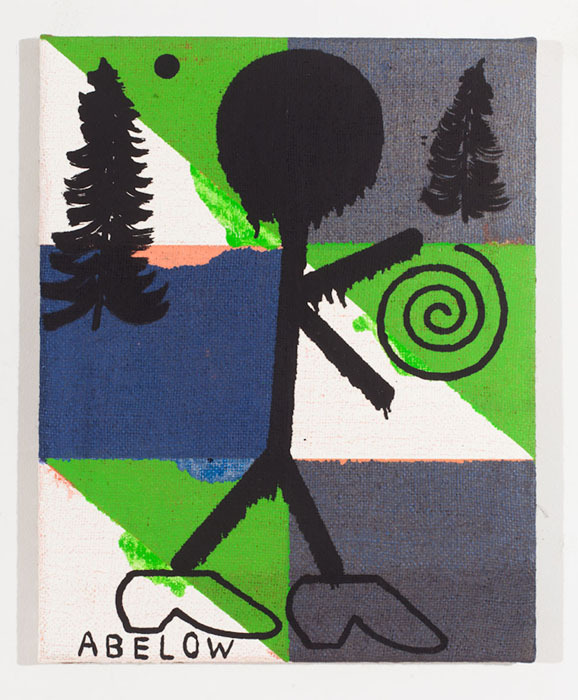An oil-on-burlap self-portrait from 2011 by Joshua Abelow, one of several self-portraits on display at Wasserman Projects.
Joshua Abelow's childish self-portraits are deceptively complex. Like his Art Brut and CoBrA artist predecessors, Abelow uses squiggles, line drawings, and simple icons to investigate deep issues of libidinal drive, neurotic complexes, and the psychological role of humor in self-portraiture. His show at Wasserman Projects presents a straightforward collection of 16 paintings and five framed drawings, but the content is anything but obvious. The paintings take up two adjoining walls, while a wall on the side displays the drawings. In a storage area placed behind a velvet rope, some of Abelow's raunchier, earlier works are hung behind the main gallery. These works are drawn from a series of sexually suggestive paintings of couples with exaggerated noses, often with the words, "Call Me" scribbled along the side.
Abelow was trained at the Rhode Island School of Design, and worked for seven years as a studio assistant for Ross Bleckner. He completed his MFA in painting at Cranbrook in 2008. Abelow's paintings show a strong appreciation of his historical forbearers, including modern masters like Paul Klee and Jean Dubuffet. In between these figurative drawings (and sometimes in their backgrounds) are abstract checker paintings that recall Sean Scully, though Abelow executes his works on burlap and in a style that is more mocking of geometric abstraction than respectful of it.
One painting shows a stick figure wearing shoes, surrounded by a spiral, two trees and an object that resembles a moon or sun. At the bottom of the painting, the artist signs/writes his own name, "ABELOW." The entire painting, which resembles a crude child's painting, sits on the background of green, blue, gray and white checkers. In a form of self-deprecating visual wordplay, the painting seems to ask if the artist can fill this pair of shoes, while the spiral--which appears between the stick figure's arms--recalls an artist's palette as well as a magic trick. At every moment, the artist seems to be delighting in his own skills while at the same time fraught with professional anxiety.
A brilliant group of drawings parodies some of Picasso's more notorious works from the 1930s. In some of Abelow's versions, male figures with oversized genitals and sometimes goulish faces carry paintbrushes. In others, the male figure (a stand-in for the artist?) interacts with female figures in inscrutable but sexually charged gestures. Two constants seem to carry through all of these works. First, they depict the artist as sometimes megalomaniacal, sometimes hopelessly insecure. Second, behind this heated internal conflict, Abelow backs up his jokes with painterly skill that, while looking casual, belies a measured and considerate ability.
John J. Corso teaches art history at Oakland University in Rochester, Michigan. He strives to write criticism that is 'partisan, passionate, and political.'

